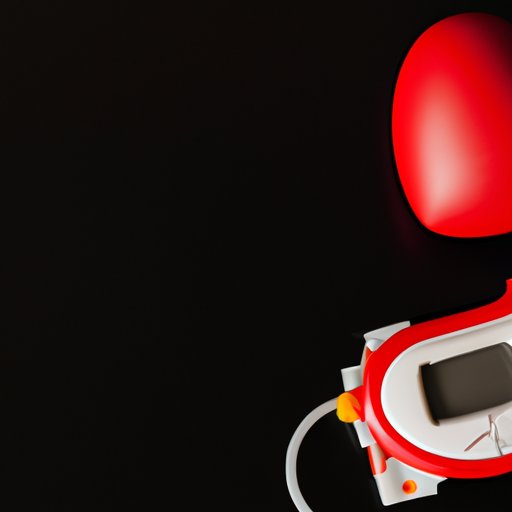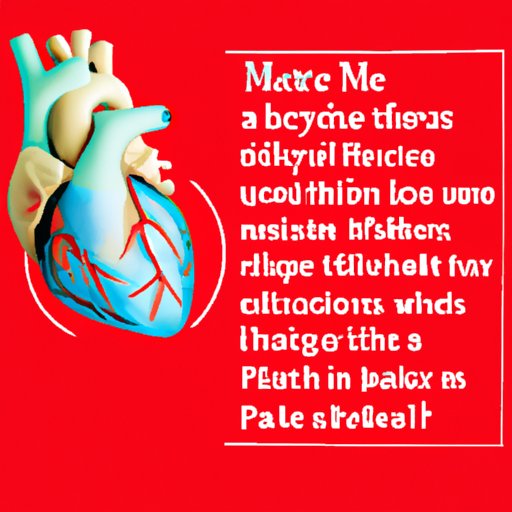
I. Introduction
Heart disease is a common condition that affects millions of people worldwide. One treatment option for heart conditions that has gained popularity over the years is the use of pacemakers. However, there is a belief that having a pacemaker is a type of heart disease, causing confusion and misinformation among patients. This article aims to explore the connection between pacemakers and heart disease, debunking the myth that having a pacemaker is considered a form of heart disease, and providing an understanding of what having a pacemaker means for heart health.
II. Understanding the Connection Between Pacemakers and Heart Disease
A pacemaker is a medical device that is implanted under the skin on the chest. It helps the heart beat at a regular rate and rhythm to improve the heart’s function. The pacemaker traces the heart’s electrical impulses and sends electrical signals via wires to the heart when necessary, which helps it to maintain a regular heartbeat. Heart diseases, on the other hand, refer to a range of conditions that affect the heart’s function, including coronary artery disease, arrhythmias, and heart failure.
The symptoms of heart disease can vary depending on the type of heart condition a person has. They include chest pain, shortness of breath, dizziness, and rapid or irregular heartbeat. In some cases, heart disease may lead to the need for a pacemaker. For example, some people with heart failure experience heart block, where the electrical signals that coordinate the heart’s rhythm are disrupted. This condition can be managed with a pacemaker, which helps regulate the heart’s rhythm by electrically pacing it.

III. Debunking the Myth: Why Having a Pacemaker Is Not a Form of Heart Disease
While it is true that some people with heart conditions may require a pacemaker, having a pacemaker is not a type of heart disease. Instead, pacemakers are used to address specific heart conditions. A pacemaker can improve the heart’s function and optimize its operation by ensuring that it beats regularly.
There are significant differences between heart disease and needing a pacemaker to manage heart conditions. Pacemakers are not used to treat heart disease directly. Still, they help manage conditions like bradycardia, which refers to a slow heartbeat, and tachycardia, which refers to a rapid heartbeat. A pacemaker is used to keep the heart at a regular pace and rhythm, ultimately improving the quality of life for the patient.
IV. What Having a Pacemaker Really Means for Your Heart Health
The insertion of a pacemaker is a minor surgical procedure that typically requires only local anesthesia. Once the pacemaker is implanted, it continuously monitors and assists the heart in maintaining a regular heartbeat. Pacemaker batteries typically last between 5-15 years.
Living with a pacemaker means adjusting to a new way of life with regular medical check-ups, changes in physical activity, and monitoring heart function. Pacemaker patients are advised to avoid extreme physical activities like skydiving and contact sports, and some may need to avoid strong magnetic fields, such as those generated by MRI scans.
While living with a pacemaker may come with some limitations, the benefits of having one outweigh the challenges. Pacemaker wearers generally experience better daily life and overall improvement in the management of their heart conditions.
V. The Role of Pacemakers in Treating Heart Disease Symptoms
Pacemakers can be an effective treatment option for managing the symptoms of heart diseases, such as arrhythmias. An arrhythmia occurs when the heart beats irregularly or too fast. This condition can cause fatigue, dizziness, and fainting spells. Pacemakers monitor the heart’s rhythm and correct it when necessary, preventing the occurrence of arrhythmia-related symptoms.
Pacemakers can also help manage symptoms of heart failure, a condition where the heart does not pump enough blood to meet the body’s needs. This happens when the heart muscle weakens and cannot pump properly. By providing regular electrical impulses, the pacemaker helps the heart to maintain a regular heartbeat, thereby improving blood flow and reducing symptoms of heart failure.
VI. Contrasting Pacemakers and Heart Disease: What You Need to Know
While heart disease and requiring a pacemaker are different, there is no denying that both can have a significant impact on a person’s quality of life. Heart disease is a chronic condition that is managed by a combination of medications, lifestyle changes, and medical procedures. On the other hand, a pacemaker is a medical device that is implanted in a relatively minor procedure and that can improve heart function directly.
When it comes to the prognosis between heart disease and requiring a pacemaker to manage heart conditions, the outlook depends on the individual’s specific circumstances. Patients with heart disease will need ongoing care from their healthcare providers, whereas pacemaker wearers require regular monitoring and maintenance of the device but are generally less limited in their daily lives.
VII. The Difference Between Living with Heart Disease and Living with a Pacemaker
Navigating life with heart disease comes with its fair share of challenges. It requires making lifestyle changes such as a heart-healthy diet and increased physical activity, avoiding triggers that could exacerbate symptoms, and managing several medications.
Living with a pacemaker also comes with changes and challenges. Pacemaker patients need to be mindful of how they live their everyday lives to ensure that the device works optimally. This can include avoiding activities and situations that may interfere with the pacemaker’s function. However, patients are generally less limited in their daily lives, and the pacemaker helps to manage their specific heart condition without the need for constant medication.
VIII. Pacemaker or Heart Disease: Which One Requires More Close Monitoring?
Both heart disease and pacemaker patients require close monitoring from their healthcare providers. Pacemaker patients need regular check-ups to ensure that the device is working correctly, and the battery is in good condition. The device’s programming may also be adjusted, affecting how the pacemaker operates.
Heart disease patients require ongoing care and monitoring that may involve medications, lifestyle changes, and other medical procedures. The intensity and type of monitoring may vary depending on the individual’s heart condition, with some patients requiring frequent visits and others more spaced out.
IX. Conclusion
Having a pacemaker is not considered a type of heart disease but is instead a medical device used to manage specific heart conditions. Pacemakers play an essential role in treating heart conditions, helping patients achieve a regular heartbeat and improved quality of life. Compared to living with heart disease, living with a pacemaker may involve different limitations, requiring closer monitoring from healthcare providers. Overall, the benefits of having a pacemaker are significant, and it is essential to understand the device’s role in managing specific heart conditions.
If you are living with heart disease or have been advised that you need a pacemaker, consult with your healthcare provider to learn more about your specific heart condition and the recommended management options. With proper care and guidance, you can successfully manage your heart condition and lead a healthy, fulfilling life.





